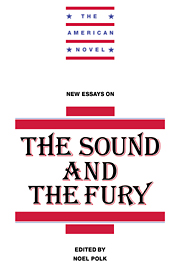Book contents
- Frontmatter
- Contents
- Series Editor's Preface
- 1 Introduction
- 2 Faulkner's Text Which Is Not One
- 3 “Now I Can Write”: Faulkner's Novel of Invention
- 4 Quentin Compson: Tyrrhenian Vase or Crucible of Race?
- 5 Trying Not to Say: A Primer on the Language of The Sound and the Fury
- Notes on Contributors
- Selected Bibliography
2 - Faulkner's Text Which Is Not One
Published online by Cambridge University Press: 23 December 2009
- Frontmatter
- Contents
- Series Editor's Preface
- 1 Introduction
- 2 Faulkner's Text Which Is Not One
- 3 “Now I Can Write”: Faulkner's Novel of Invention
- 4 Quentin Compson: Tyrrhenian Vase or Crucible of Race?
- 5 Trying Not to Say: A Primer on the Language of The Sound and the Fury
- Notes on Contributors
- Selected Bibliography
Summary
IN ITS SIXTY years of public life, The Sound and the Fury has inspired different degrees of enthusiasm. From early assessments that judged it “a trifle unhealthy” to others that found it “downright tiresome,” it has managed to remain, even in these days of canon cross fire, in the expropriated words of Faulkner, “our heart's darling” – a book “we” love to teach. To write about it in 1992 is to confront the critical monolith, made worse now because there seems little left unsaid about a work that properly, intentionally, and “officially” failed. Even the book's own designated heart's darling, Caddy herself, has endured a contested critical history: she has been both examined as the source of Compson ruin and elevated to the status of “the beautiful one.” Each critical construction of her has been replicated many times over. Faulkner's decision to deny her a narrative voice has worked to spawn dozens of apologias which seek to demonstrate that her absence is central, central to the novel, central to the brothers' lives and memories, central to the structural strategy of the work, central to its rhetoricized tragedy, central even to the fall of the South. Faulkner aided and abetted this compelling interpretation when he claimed to have written the book to appease his haunted desire for a sister that never was, for the daughter he lost, and who – in the ritualized telling – became the metaphorically beautiful urn which in turn became, finally, something to die for or with.
- Type
- Chapter
- Information
- New Essays on The Sound and the Fury , pp. 23 - 70Publisher: Cambridge University PressPrint publication year: 1993
- 3
- Cited by



